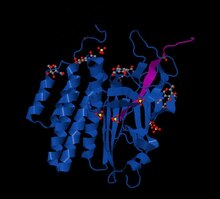
The GAIN domain (G-protein-coupled receptor (GPCR) autoproteolysis-inducing domain) is a protein domain found in a number of cell surface receptors, including adhesion-GPCRs and polycystic kidney disease proteins PKD1 and PKD2. The domain is involved in the self-cleavage of these transmembrane receptors, and has been shown to be crucial for their function[citation needed].[1] Point mutations within the GAIN domain of PKD1 and GPR56 are known to cause polycystic kidney disease and polymicrogyria, respectively.[2][3][4]
References[edit]
- ^ Trudel, Marie; Yao, Qin; Qian, Feng (2016-01-21). "The Role of G-Protein-Coupled Receptor Proteolysis Site Cleavage of Polycystin-1 in Renal Physiology and Polycystic Kidney Disease". Cells. 5 (1): 3. doi:10.3390/cells5010003. ISSN 2073-4409. PMC 4810088. PMID 26805887.
- ^ Araç, D; Boucard, AA; Bolliger, MF; Nguyen, J; Soltis, SM; Südhof, TC; Brunger, AT (Feb 14, 2012). "A novel evolutionarily conserved domain of cell-adhesion GPCRs mediates autoproteolysis". The EMBO Journal. 31 (6): 1364–78. doi:10.1038/emboj.2012.26. PMC 3321182. PMID 22333914.
- ^ Lin, HH; Chang, GW; Davies, JQ; Stacey, M; Harris, J; Gordon, S (Jul 23, 2004). "Autocatalytic cleavage of the EMR2 receptor occurs at a conserved G protein-coupled receptor proteolytic site motif". The Journal of Biological Chemistry. 279 (30): 31823–32. doi:10.1074/jbc.M402974200. PMID 15150276.
- ^ Chang, GW; Stacey, M; Kwakkenbos, MJ; Hamann, J; Gordon, S; Lin, HH (Jul 17, 2003). "Proteolytic cleavage of the EMR2 receptor requires both the extracellular stalk and the GPS motif". FEBS Letters. 547 (1–3): 145–50. doi:10.1016/S0014-5793(03)00695-1. PMID 12860403. S2CID 23329033.